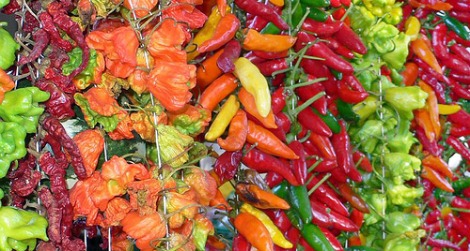
If spicy fruits are helpful to a chili plant, why aren't all chili peppers hot? (courtesy of flickr user dbeck03)
Capsaicin, the molecule that gives chilies their heat, it turns out, helps protect chili fruits from fungal rot and munching rodents without deterring the birds that the plant needs to distribute the seeds in the fruit.
But that leads to a new question—why aren’t all chili peppers hot? Tewksbury’s lab has an answer to that, too, in a study published last month in the Proceedings of the Royal Society B.
David Haak, then a graduate student in Tewksbury’s lab and now a post-doc at Indiana University, studied Capsicum chacoense, a species of wild chili in Bolivia that occurs either in populations of only hot chilies or in mixed populations with hot and mild fruits. Haak, Tewksbury and their colleagues found that in the wettest parts of their research area, only hot chilies grew. The driest places, though, were home to mixed populations, with only 15 to 20 percent of the plants producing spicy fruits.
The researchers collected hot and mild fruits from three sites in their study area, spanning the range of rainfall and population types. They grew the seeds in the lab, giving the plants either plenty of water–mimicking the wettest areas in which the plants grew–or not enough water, as in the dry areas.
Both mild and spicy plants grew well when there was plenty of water, the researchers found. And there was no cost to producing lots of capsaicin–spicy plants produced just as many seeds as mild ones. But because Fusarium, the fungus that attacks chili plants in Bolivia, likes wet conditions, the mild plants would be more vulnerable and not able to survive. That’s why spicy chilies dominated the wetter areas of Bolivia, Haak and his colleagues concluded.
When the plants were subjected to drought-like conditions, though, spicy plants produced only half the number of seeds as the mild ones. GrrlScientist at Maniraptora: Tastes Like Chicken explains:
Plants lose water through microscopic pores in their leaves and stems, known as stomata. During the day, plants release oxygen to the environment in exchange for carbon dioxide through their stomata, but this vital gas exchange comes at a price: water loss. Knowing that the density of stomata on a plant’s leaves directly affect water loss, the team compared stomata density from 30 age- and height-matched pungent and non-pungent chili plants.
They found that pungent plants have a 40 percent greater stomata density on their leaves than do non-pungent plants. Even after cross-breeding pungent with non-pungent plants and then identifying whether the fruits were pungent, the team found that the pungent crossbred chilis still had a greater stomata density than non-pungent crossbreds.
Because the spicy plants lose more water, they’re not able to produce as many seeds. And with Fusarium not as big of a problem in the dry conditions and the mild plants’ greater ability to hold onto water and produce more seeds, those plants are able to thrive in the driest conditions and easily outgrow their spicy brethren there.
ليست هناك تعليقات:
إرسال تعليق